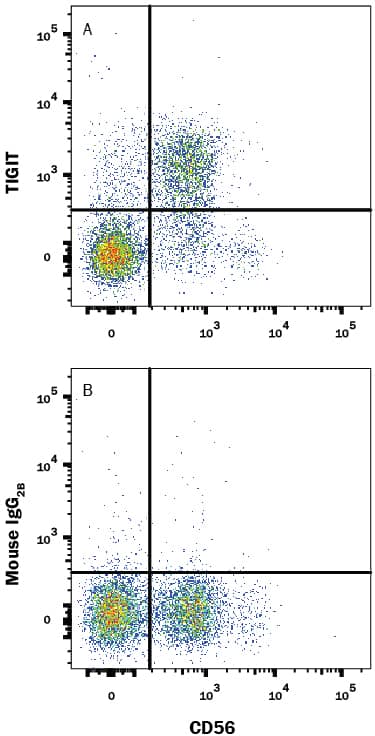Human TIGIT PE-conjugated Antibody
R&D Systems, part of Bio-Techne | Catalog # FAB7898P


Key Product Details
Species Reactivity
Validated:
Cited:
Applications
Validated:
Cited:
Label
Antibody Source
Product Specifications
Immunogen
Met1-Pro141
Accession # Q495A1
Specificity
Clonality
Host
Isotype
Scientific Data Images for Human TIGIT PE-conjugated Antibody
Detection of TIGIT in Human PBMCs by Flow Cytometry.
Human peripheral blood mononuclear cells (PBMCs) gated on CD3-cells were stained with Mouse Anti-Human NCAM-1/CD56 APC-conjugated Monoclonal Antibody (Catalog # FAB2408A) and either (A) Mouse Anti-Human TIGIT PE-conjugated Monoclonal Antibody (Catalog # FAB7898P) or (B) Mouse IgG2BPhycoerythrin Isotype Control (Catalog # IC0041P). View our protocol for Staining Membrane-associated Proteins.Applications for Human TIGIT PE-conjugated Antibody
Flow Cytometry
Sample: Human peripheral blood mononuclear cells (PBMCs)
Reviewed Applications
Read 2 reviews rated 5 using FAB7898P in the following applications:
Formulation, Preparation, and Storage
Purification
Formulation
Shipping
Stability & Storage
Background: TIGIT
TIGIT (T cell Immunoreceptor with Ig and ITIM domains), also called Vstm3 (V-set and transmembrane domain-containing 3), Vsig9 (V-set and Ig domain-containing 9) and WUCAM (Washington University cell adhesion molecule) is a 30-34 kDa type I transmembrane protein that is a member of the CD28 family within the Ig superfamily of proteins (1-4). Human TIGIT cDNA encodes 244 amino acids (aa) including a 21 aa signal sequence, a 120 aa extracellular region with a V-type Ig-like domain and two potential N-glycosylation site, a 21 aa transmembrane sequence, and an 82 aa cytoplasmic domain with an ITIM motif (5). A 170 aa variant diverges after aa 166 (5). Within the ECD, human TIGIT shares only 68-75% aa sequence identity with mouse, porcine, canine, equine and bovine TIGIT. TIGIT is expressed on NK cells and subsets of activated, memory and regulatory T cells, and particularly on follicular helper T cells within secondary lymphoid organs (1, 2, 6-8). It binds to CD155/PVR/Necl-5 and Nectin-2/CD112/PVRL2 that appear on dendritic cells (DC) and endothelium (1-3, 7). Binding of TIGIT by DC induces IL-10 release and inhibits IL-12 production (2). Ligation of TIGIT on T cells down‑regulates TCR-mediated activation and subsequent proliferation, while NK cell TIGIT ligation blocks NK cell cytotoxicity (6-8). Through CD155 and Nectin-2, which also interact with DNAM-1/CD226 and CD96/Tactile, TIGIT is part of an interacting network of Ig superfamily members that may augment or oppose each other (3, 4, 6, 7). In particular, TIGIT binding to CD155 can antagonize the effects of DNAM-1 (6, 7). Soluble TIGIT is able to compete with DNAM-1 for CD155 binding and attenuates T cell responses, while mice lacking TIGIT show increased T cell responses and susceptibility to autoimmune challenges (2, 3, 8).
References
- Boles, K.S. et al. (2009) Eur. J. Immunol. 39:695.
- Yu, X. et al. (2009) Nat. Immunol. 10:48.
- Levin, S.D. et al. (2011) Eur. J. Immunol. 41:902.
- Xu, Z. et al. (2010) Cell. Mol. Immunol. 7:11.
- SwissProt Accession # Q495A1.
- Seth, S. et al. (2009) Eur. J. Immunol. 39:3160.
- Stanietsky, N. et al. (2009) Proc. Natl. Acad. Sci. USA 106:17858.
- Joller, N. et al. (2011) J. Immunol. 83:1338.
Long Name
Alternate Names
Gene Symbol
UniProt
Additional TIGIT Products
Product Documents for Human TIGIT PE-conjugated Antibody
Product Specific Notices for Human TIGIT PE-conjugated Antibody
For research use only